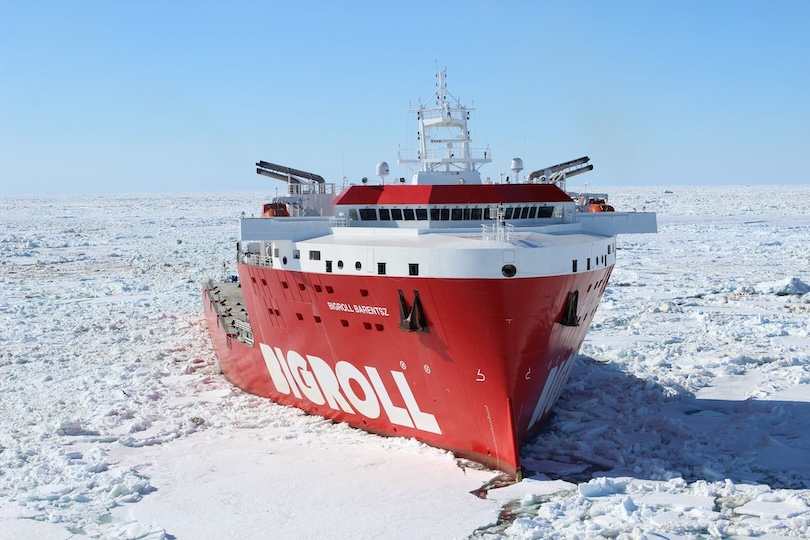Icebreaker vessel is an engineering marvel specifically designed to navigate through ice-covered waters, ensuring safe passage for other ships and supporting various activities in polar regions. The construction of these robust icebreaker vessels involves a combination of specialised design features, advanced materials, and cutting-edge technologies that allow them to operate effectively in some of the harshest environments on Earth. If you ever been curious on how an icebreaker vessel is made, down below you can find some useful information:

Icebreaker Vessel – How is Made
Design Considerations
The design of an icebreaker vessel is carefully crafted to meet the unique challenges posed by ice-covered seas. One of the key considerations is the strengthened hull, which is reinforced to withstand the immense pressure exerted by the ice. Icebreakers typically have a rounded or sloping shape at the bow, known as an icebreaking hull, which enables them to ride up onto the ice and use their weight to crack and break it. This design minimizes the resistance encountered when moving through ice-covered waters, allowing the vessel to navigate efficiently.
Additionally, the power and propulsion systems of icebreakers are specially designed to provide sufficient thrust for breaking through ice. High-powered engines, often diesel-electric or nuclear, are employed to generate the necessary energy. Some icebreakers are equipped with multiple propellers and thrusters to enhance maneuverability, allowing them to navigate through intricate ice formations.
Hull Construction
The hull construction of an icebreaker vessel is a critical aspect of its design, given the harsh conditions it will encounter. Icebreakers typically feature a double or reinforced hull, adding an extra layer of protection against potential damage from ice impacts. The materials used in the hull’s construction are carefully selected for their strength and durability. High-tensile steel is a common choice, as it can withstand the forces exerted by ice and provides the necessary structural integrity.
To further enhance the icebreaking capabilities, some icebreakers incorporate innovative technologies such as a lubricating system. This system releases a film of air or water between the hull and the ice, reducing friction and allowing the vessel to glide more easily through the frozen waters.
Power and Propulsion Systems
The power and propulsion systems of icebreakers are designed to deliver exceptional performance in challenging ice conditions. Diesel-electric propulsion is a common choice, offering a combination of power, efficiency, and flexibility. Diesel engines drive generators that produce electrical power, which is then used to operate electric motors connected to the propellers. This setup allows for precise control of the propulsion system, contributing to the icebreaker’s maneuverability.
In some cases, icebreakers are nuclear-powered, relying on a nuclear reactor to generate steam that drives turbines connected to the propellers. Nuclear-powered icebreakers are known for their extended operational range and endurance, making them suitable for long missions in remote polar regions.
Advanced Navigation Systems
Icebreakers are equipped with advanced navigation systems to ensure safe and efficient operation in ice-covered waters. The vessels are often outfitted with radar systems, sonar, and ice reconnaissance tools that provide real-time information about ice conditions. This data helps the crew navigate through ice formations, identify the safest routes, and anticipate potential challenges.
GPS (Global Positioning System) technology is crucial for precise navigation, allowing icebreakers to maintain accurate positioning even in remote polar areas where traditional navigation landmarks may be scarce. Additionally, some icebreakers are equipped with ice-mapping sonar, which can create detailed maps of the underwater ice features, aiding in route planning and avoiding underwater obstacles.
Construction Challenges
Building icebreaker vessel involves overcoming several engineering challenges, especially when constructing large and powerful icebreakers designed for Arctic or Antarctic missions. The extreme environmental conditions, including sub-zero temperatures and icy waters, pose challenges for both the construction process and the materials used.
Special attention is given to the welding techniques used in the construction of the hull. Welding must be performed with precision to ensure the integrity of the structure, and materials must be carefully selected to withstand the low temperatures and potential impacts from ice.
The construction of nuclear-powered icebreakers adds another layer of complexity. The integration of a nuclear reactor requires stringent safety measures, thorough testing, and compliance with international regulations. The design must account for the unique challenges associated with nuclear propulsion, ensuring the safety of both the crew and the environment.
Innovation in Icebreaker Construction
As technology advances, ongoing innovation in icebreaker vessel construction continues to enhance the capabilities of these vessels. Researchers and engineers are exploring new materials, such as high-strength alloys and composites, to further improve the strength-to-weight ratio of icebreaker hulls. This not only enhances their icebreaking efficiency but also contributes to overall fuel efficiency.
Automation and remote sensing technologies are also being integrated into icebreaker vessel systems to improve operational efficiency and reduce the workload on the crew. Autonomous systems, including remotely operated vehicles (ROVs) and unmanned aerial vehicles (UAVs), are used for ice reconnaissance and data collection, providing valuable information for navigation and decision-making.
Icebreaker vessel represent a remarkable fusion of engineering prowess and technological innovation. From their reinforced hulls to advanced propulsion systems, these vessels are purpose-built to navigate through ice-covered waters, ensuring safe passage for other ships and supporting various activities in polar regions. As the demand for access to the Arctic and Antarctic regions grows, the construction and design of icebreakers will likely continue to evolve, driven by a commitment to safety, efficiency, and environmental sustainability in one of the planet’s most challenging environments.

Comments
One response to “The Construction of Icebreaker Vessel: Engineering Marvel for Polar Navigation”
[…] shipyard optimizes workflow and resource utilization. Shipbuilding Capacity: CSSC’s annual shipbuilding capacity reaches an impressive 4 million DWT, solidifying its status as a key player in the global […]